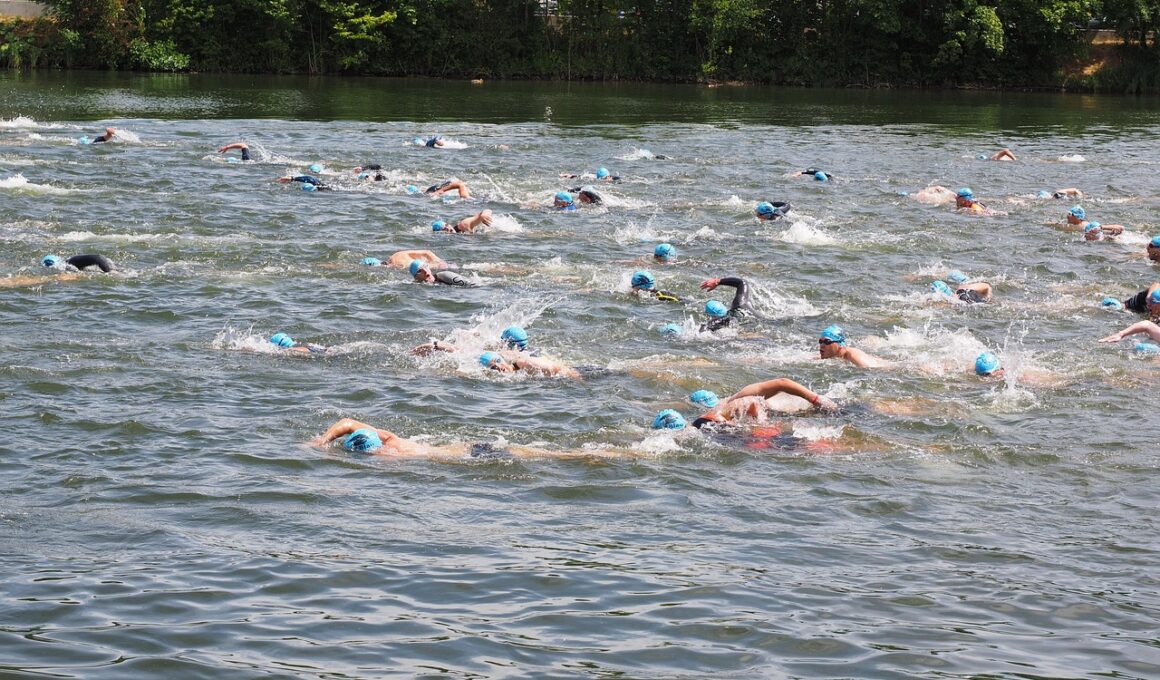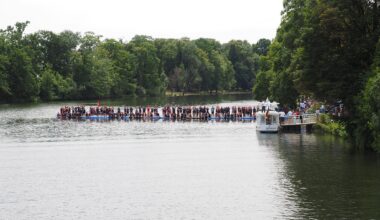How to Incorporate Swimming Drills into Your Triathlon Training Routine
Triathlon training often emphasizes the importance of swim drills that enhance performance and technique. Implementing swimming drills allows triathletes to refine their strokes, improve their breathing, and develop overall swimming efficiency. A structured approach to swimming drills will help build endurance, speed, and confidence as you navigate through the water. Making swimming drills an essential part of your training routine will significantly improve your swim leg in a triathlon. Prioritize a variety of swim drills that focus on different skills, such as drills for strength, speed, and endurance. Choosing to include specific drills will help enhance your swimming experience, providing clear benefits on race day. As you begin, ensure your drills maintain a high level of intensity. Additionally, it’s wise to assess your swimming technique frequently. Working with a coach or watching videos can help identify areas of improvement. Over time, you’ll notice how effective swimming drills significantly contribute to your overall triathlon success and can make a real difference in your race performance.
Types of Swimming Drills
Incorporate diverse swimming drills to target a variety of skills. Each drill has a unique purpose and can help enhance specific aspects of your swimming. Common types of swimming drills include the following: 1. Drill for Body Position – This helps you maintain a streamlined posture in the water. 2. Catch-up Drill – Focuses on the arm recovery phase. 3. Single Arm Drill – Improves balance and rotation while developing stroke efficiency. 4. Sculling Drill – Enhances feel for the water while improving hand entry technique. 5. Kickboard Kicking – Develops leg strength and a powerful kick. 6. Pull Buoy Swimming – Concentrates on upper body strength while releasing leg muscles. 7. Breathing Drills – Encourages proper breathing patterns and rhythm. Incorporating these drills into your swim sessions can yield remarkable benefits. Establish a weekly schedule dedicated to swimming drills, focusing on one or two specific drills each session. Experiment with various drills to understand which ones benefit your performance the most. This variation can also keep your training exciting and help you stay motivated.
Before starting any workout, ensure you warm up adequately. A proper warm-up not only prepares your muscles but also prevents injuries that could affect your training progress. You might start a warm-up with light swimming to loosen up, followed by some dynamic stretching exercises. After warming up, implement your specific swimming drills focusing on technique and form. Don’t be afraid to slow down initially to perfect your strokes before increasing your speed. Consistent practice with the correct technique will produce more efficient swimmers. Additionally, always incorporate rest intervals while training. Allowing your body time to recover enhances performance and reduces fatigue. A good rule of thumb is maintaining a 1:3 work-to-rest ratio. As you progress, consider varying your interval training with the drills, adding elements of speed or endurance. Furthermore, track your progress to see how your swimming drills come together during competitions. Frequent reviews can inform your training strategy and identify areas requiring improvements. Progress should be acknowledged, ensuring you remain dedicated to your triathlon journey and the development of your swimming technique.
Tracking Your Progress
Tracking your swimming practices and the drills will provide valuable insights into your performance. Use a training log or an app to record your swim workouts, detailing the drills completed, distances swum, and any observations during training. This information can help you adjust your training strategy for improved effectiveness. Reviewing your log regularly will also help highlight your strengths and weaknesses and reveal trends over time. Set specific, measurable goals related to each drill and ensure you monitor your progress toward achieving them. This could involve setting times for each drill or focusing on fewer strokes, depending on your current goals. Additionally, swim video analysis can be an invaluable tool in examining your technique and identifying areas for improvement. You can video yourself while swimming with drills, then reviewing the footage for corrections. Obtaining feedback from experienced swimmers or coaches is important, as their insights can lead to considerable advancements. Ultimately, an organized approach focused on tracking allows consistent improvement, supporting your overall triathlon performance and increasing confidence in your swimming ability.
Incorporate swimming drills into your actual workouts by integrating them into longer swims. For example, after a warm-up, swim a specific drill for a certain distance before returning to your base pace. Applying drills in the context of a workout will help solidify the technique you are trying to master. Combining this approach results in a more well-rounded swim session. Having a plan for each session means you can address specific skills while also building endurance. You may choose to perform a drill set during the main set of a swim workout or focus a dedicated session solely on drills to hone your skills. Always remember to listen to your body and adjust as necessary. If you feel fatigued, consider scaling back on volume and intensity. Additionally, late in the training cycle, you should increase the intensity of these workouts to prepare yourself for race day. Maintaining consistency during your training will help your swimming technique become second nature when racing, allowing you to focus on other crucial triathlon aspects.
Benefits of Swimming Drills
Incorporating swimming drills into your routine yields various benefits. Firstly, they lead to improved technical efficiency, allowing for smoother and more effective swimming strokes. You’ll notice that with practice, your body mechanics in the water become refined, improving propulsion. Furthermore, drills help develop muscle memory, allowing you to perform strokes with less conscious effort. This increased efficiency translates to less fatigue and better overall endurance while competing. Secondly, swimming drills promote strength training, building and fortifying key muscle groups utilized during swimming. This muscular strength is essential for maintaining speed over longer distances in races. Thirdly, swimming drills can be enhanced by feeling the water better, presenting a significant advantage during competitive events. Fourthly, these drills enhance your mental focus, as many require attention to specific details of your swim. This focus will benefit you during your races, especially under the intense pressure of competition. Integrating these various drills will ultimately result in more effective swimming, improving your performance during race day and providing you with more confidence in your abilities.
As race day approaches, consider tapering your swimming drill intensity and focus on maintaining skill while recovering for peak performance. Adjust your swim sessions to reduce overall volume but maintain the drill practice to keep your technique sharp. This ensures your body recovers from intense training while solidifying the improvements you’ve made through swim drills. Include some light swim workouts focusing on maintaining comfort in the water and consistency in your technique. After completing your last big training cycle, aim for a week of less intense workouts. Resisting the urge to push too much during this period is essential. Concentrating on quality drills while minimizing intensity allows the body to recover effectively. This recovery phase ensures that you’ll be fresh for race day, ready to apply all you’ve practiced in your training. On race day, remain confident in your preparation. Trust that your training and drill practice have equipped you well to perform efficiently and effectively. Execute your swimming strategy and adapt as needed during the race, remembering all the hard work you’ve committed to your triathlon journey.


